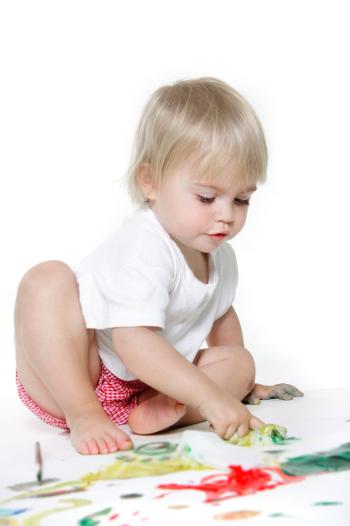Make your own Christmas wrapping paper
Duration/age

Instead of buying wrapping paper and gift bags this year you could try to make your own. Your child could help you.
Talk about what kind of wrapping paper you want to make. You could draw pictures, create dotty paper using stickers that are round, or use paint to create different designs. Will you use lots of different colours to create a rainbow? Would you rather use just one or two colours to make it match the decorations on your Christmas tree?
Our Christmas tree has red and green decorations. We can make paper that will match.
The tree has lots of red and green baubles. I wonder if we can make paper that has the same round shapes on it.
You can print your own paper using paint or stamp pads. Before you start, decide what shapes you want on your paper. Will it have stars, spots and stripes or a mixture of everything? Once you have decided on your shapes, go on a hunt around the house for objects you can use.
I want the paper to have stars and spots. We could use biscuit cutters and corks.
Once you have finished your wonderful Christmas creations peg them on the clothesline to dry.
Materials you will need
- Paint
- Glitter
- Stickers
- Textas
- Brown or white paper
- Shapes for printing
Alternative tools
- Glue
- Paper bag
- Stamps and stamp pad
- Cut-out shapes
- Found objects
Skills this activity improves
Why does this matter?
As your child helps you to create the wrapping paper they are developing language to describe what they are doing and seeing. As you work together and make decisions about how the paper will look your child will be using descriptive mathematical language. They will be using language to describe colour, shape, size and position.
Creating their own wrapping paper helps children to develop fine motor skills and spatial awareness. As they create their own paper they are experimenting with space and where to place their ideas on the page. They will be exploring how to make an object large or small. They will also be adding patterns and details that give meaning to their ideas.
What does this lead to?
As your child creates their own wrapping paper they are developing hand dominance (left hand vs right hand) and hand control. This is important to enable children to write for extended periods of time and to create small detailed pictures. If a child has not developed good hand control they will tire quickly when writing, use their shoulder to move the hand rather than the wrist and will find it difficult to create small connected letters.
Working together with your child to create the paper will give your child an opportunity to use and hear the language of measurement and position. As you talk to your child you will be describing where to place the detail - will it be close to the edge or in the middle of the paper?
“We need to put more big green dots near the middle of the paper.”
“There is no room for big stars near the edge of the paper but we could fit some small spots.”
Language to use
- Size, shape, colour
- Position, location, edge, middle, side, around, next to, between
- Star, circle, stripe, spot, swirl
- Draw, print, paint
Questions to use
- How many shapes can we fit on the page?
- Which colour will we use?
- Are there more big shapes or more small shapes?
- Where will we start printing? In the middle or near the edge?
Useful tips
- An old grown-up's shirt makes a great children's painting smock.
- If your child gets paint on their clothes, wash them in cold water. Hot water helps to set the paint.
- You might also like to take a look at the activities Painting and Making marks.
- Little children will find it tricky to hold small shapes.
- Remember to talk to your child in your home language.
More ideas
- Cut shapes from sponges to use for printing.
- Cut shapes into ice-cream lids. You can use them as painting stencils or to trace around.
Variation by age
Birth to two year olds
- You could paint your child’s hands and get them to create handprints.
- Mix vegetable dye with water to create a paint wash. Your child can use big brushes to spread the colour across the page.
- Find different drawing equipment for your child to create marks, images and designs on the page.
Three to five year olds
- You could paint your child’s hands and get them to create hand prints.
- Mix vegetable dye with water to create a paint wash. Your child can use big brushes to spread the colour across the page.
- Find different drawing equipment for your child to create marks, images and designs on the page.
- Look through books to find inspiration when creating your own designs and wrapping paper.


